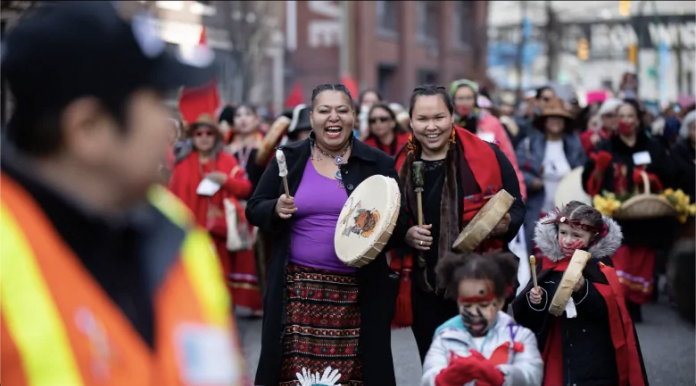by Saman Dara, SFU Student
Indigenous women are leaders, community developers, Knowledge Keepers, negotiators, and life givers; they are the heart of their Nations. In order to fulfill these roles, Indigenous women require space, health, and safety, all of which are increasingly difficult to find under the intersecting forces of gender-based violence, poverty, and racism. The federal government has shown lackluster effort in implementing an action plan to protect Indigenous women and girls from these inequities. This is failing communities, and missing and murdered Indigenous women and girls (MMIWG) across Canada, and there should be greater recognition of that.
The Women’s Memorial March was started by Indigenous women in Vancouver’s Downtown Eastside (unceded Coast Salish territory) in 1992, and is held every Valentine’s Day to honour MMIWG affected by continuing injustice. The March seeks to bring attention to the disproportionate loss of Indigenous women from the Downtown Eastside.
These issues have received more wide-spread attention since the 2015 announcement of an official inquiry into MMIWG. Indigenous women and girls are 12 times more likely to be murdered or go missing compared to all other women in Canada. The 2019 National Inquiry’s Final Report on MMIWG acknowledges this truth through survivor and family member testimonies. The report also cites systemic, oppressive structures, such as “specific colonial and patriarchal policies” and “intergenerational trauma and marginalization,” as causes.
In adherence with this report, the federal government affirmed to carry out a National Action Plan by June 2020. COVID-19 restrictions have hindered this plan, but they have also been making it more difficult for Indigenous women and girls to receive support. The Downtown Eastside’s means of support (including housing) are decreasing, leaving Indigenous women and girls at most risk of gender-based violence. It is more than apparent that the Canadian government needs to take action to protect Indigenous women and their right to thrive.
Repeatedly, Canada’s many levels of government wait for a tragedy to occur before they appear to take Indigenous peoples’ concerns seriously. Indigenous leaders were forced to make their demands for an action plan clear once again following the racial abuse and death of Joyce Echaquan at a Quebec hospital, and the downgraded charge for Barbara Kentner’s murderer. Ontario Regional Chief RoseAnne Archibald recently called on “both levels of government to develop a strong joint action plan with First Nations” to protect Indigenous women. The Chair of the First Nations Women’s Caucus, Anna Betty Achneepineskum, also advocated for the government to “address the patriarchal systems, policies, laws, and attitudes that contribute to systemic racism, discrimination, and injustices.” Clearly, the government is not prioritizing the effective collaboration needed to support Indigenous leaders and their communities.
It is disheartening that reconciliation efforts by the Canadian government continue to be neglectful of true action.
Investigating and addressing the “the causes of, and remedies for, the disproportionate victimization” of Indigenous women and girls is one of the 94 Calls to Action made by the Truth and Reconciliation Commission (TRC) of Canada. The TRC was initially founded to acknowledge and document the injustices caused by the legacy of residential schools. Ultimately, the TRC is a means to educate Canadians and work towards reconciliation, and their calls to action have been active since 2015. In December 2020, three former commissioners of the TRC expressed concerns that implementation of these goals by the government seem to be “slow and uneven.” It is disheartening that reconciliation efforts by the Canadian government continue to be neglectful of true action.
The Women’s Memorial March, in its 30th year, continues to be an opportunity for Indigenous families, communities, and organizers to grieve lost ones. It commemorates where these women were last seen or found. The March is largely led by Indigenous women, who should always be the leading voices in this arena. For non-Indigenous allies, the March should implore us to commit to raising awareness, support, and resources in the hopes that those affected or who have lost a loved one can heal. We should keep missing and murdered Indigenous women and girls in our hearts this Valentine’s Day, as it doesn’t seem like the Canadian government will.
All genders are welcome to support Indigenous women and girls in the march which begins at noon on Hastings and Main Street. Social distancing and masks are required to participate in-person. RSVP to [email protected] to join the SFSS Women’s Centre’s company. Donations to the Downtown Eastside Women’s Centre help to fund the march.




